Exhibition Texts
YOYI! Care, Repair, Heal
Introduction
YOYI! Care, Repair, Heal invites 25 artists and collectives to examine how human and interspecies kinship may be found in diverse cultural expressions. In dialogue with an international curatorial team, they address health, fair land use and distribution, ceremony, recent history and decolonial practices. The relevance of these issues has been increasingly palpable in recent years, marked by the acceleration of the climate emergency, global pandemics, political instabilities and the rise of authoritarian and populist regimes.
Care, repair and heal are loaded terms that can manifest different ways of being. They span from grief to ecstasy, from ancient Indigenous to new forms of empathy. The title YOYI is a Tiwi word (Aboriginal Australia) that is a call to ceremony, celebration and mourning. We propose to follow this call in order to embrace the presence of ancestors towards intergenerational healing and trauma; to share the Earth’s resources with non-human agents who have equal claims to possible futures; to experience the body in dance, song, rituals and multilingual communication; to reflect on accessibility and inequalities within the existing care systems; to celebrate artists who change prevailing structures through their doing.
The works critically challenge, reinvent, expand, perpetuate and disavow approaches to caring, repairing and healing. Some artists provide a critical lens on how infrastructures of care have been misused or how history has proven that healing is impossible. Others construe repair from a range of non-European perspectives. Healing and care work often defy linear time. This exhibition may be experienced as a deeper reflection on how these processes can be unveiled in a public space.
With works and contributions by Pierre Adler, Brook Andrew, Kader Attia, Tosh Basco, Mohamed Bourouissa, Andrea Büttner, Lavkant Chaudhary, Lygia Clark, André Eugène, Artemisia Gentileschi, Johanna Hedva, Jilamara Arts & Crafts Association, Anne Duk Hee Jordan, Eva Koťátková, Betty Muffler & Maringka Burton, Grace Ndiritu, People’s Archive of Rural India, Outi Pieski, Paula Rego, Tabita Rezaire & Amakaba, Georgia Sagri, Yhonnie Scarce, Reginald Sénatus (Redji), SERAFINE1369 and Wu Tsang
Central terms of the exhibition texts can be found in the exhibition glossary.
Jilamara Arts & Crafts Association: YOYI
Jilamara Arts & Crafts Association, YOYI (dance), 2020, 4-channel video installation (detail)
Collectively lead film production by artists of Jilamara Arts & Crafts Association, Milikapiti, Melville Island, Tiwi
“The Tiwi Islands have been the home of my people for thousands of years. When we connect through ceremony by dancing and singing, we also connect with the land. It makes us feel strong.”
— Pedro Wonaeamirri for Jilamara Arts & Crafts Association
YOYI means dance in Tiwi and is a collaborative film made by 30 artists who work at Jilamara Arts & Crafts Association on remote Melville Island, Australia. Jilamara refers to an ochre body paint design and is the eponym for the Tiwi-run and owned arts organisation, incorporated in 1989, composed of Aboriginal artists from the Milikapiti community. Encompassing courses, workshops, training, career support and representation, Jilamara is a community of around 60 artists who often work in ochre painting, carving and screenprinted textiles.
YOYI (2020) is a collective portrait and an archive of cultural practices for future generations. Self-directed by the artists, the film celebrates the performative foundations of Tiwi artmaking. To the constant rhythm of clapping and singing, YOYI shows individual artists wearing ceremonial garments and Jilamara while performing their totem dances. In doing so, they refer to Country – their land and their spiritual identity. YOYI is a contemporary artwork, community archive and celebration of culture shared through the medium of film.
People’s Archive of Rural India (PARI): The Grindmill Songs Project
“Keep moving along the path of emancipation
In spite of poverty, do not give up education
Put an end to enslavement, keep your self-respect alive
Come together one by one, strengthen the collective”
— Radhabai Borhade
The Grindmill Songs Project (2020–ongoing) is based on an archive, dating back to 1987, of approximately 100,000 folk songs by nearly 3,500 performers on the experiences of everyday life in rural Maharashtra, western India. Consisting of text, sound and video, the archive is taken care of by novelist Namita Waikar and her team at the People’s Archive of Rural India (PARI). Comprised of writers, filmmakers and photographers,the not-for-profit organisation was founded by journalist and editor Palagummi Sainath to provide visibility to India’s rural population of over 800 million people.
Grindmill ovi are song couplets that are traditionally sung by women as they grind flour at the jāte (grinding mill). They offer a glimpse of the poetry, traditions and resistance perpetuated by rural women. The song couplets include lines about mourning, women’s health, matrilineal relations, daily labour, nourishment, caste discrimination, seasonal cycles and the preservation of community. The archive embodies communal knowledge while demonstrating the relationship between the body, voice and daily activities.
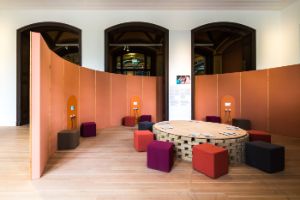
YOYI! Care, Repair, Heal, People’s Archive of Rural India (PARI): The Grindmill Songs Project, Installation view, Gropius Bau (2022)
photo: Laura Fiorio
Eva Koťátková: Confessions of a Piping System
Eva Koťátková, Confessions of a Piping System, 2019. Installation view, Confessions of the Piping System, Kunsthal Charlottenborg
courtesy: Eva Koťátková, Meyer Riegger Berlin/Karlsruhe, photo: David Stjernholm
Eva Koťátková’s sculptures, texts and performances investigate how individuals and groups are silenced, discriminated against or policed by states and institutions. As founder of the platform Institute of Anxiety, Koťátková is interested in the concept of health and illness in relation to social, political and ecological forces.
Confessions of a Piping System (2019) features an array of protest slogans and cutouts protruding from a cage like environment, evoking entrapment or powerlessness. The slogans address mental and physical issues in relation to work and other normative pressures of contemporary life. They are extracted from interviews the artist held as part of her research. Declaiming these slogans throughout the exhibition, performers amplify the voices of affected groups. Laying within the cage, their posture captures helplessness and unease, the often-unspoken burdens that everyday structures add to how we feel, experience and connect in this world.
Performers will regularly activate the work on Thursdays, 17:00–19:00.
Kader Attia: Untitled
“The denial produced by the modern certainty of the wound’s erasure is not innocent. It has a purpose, which is metaphorically present in the erasure of the colonial crime.”
— Kader Attia
Kader Attia’s artistic practice is a comprehensive examination of the concept of repair, especially that necessitated by colonial and imperialist violence. He explores how reparation is connected to memory by investigating acts of restitution, bodily and psychological traumas as well as the immateriality of wounds embodied in concrete and abstract objects. This newly commissioned installation is based on several interviews with psychoanalysts. It surveys the legacy of the collective trauma that continues over three decades after the reunification of East and West Germany. It is also a study of the coloniality that persists in some ways among the descendants of colonised Algerians, from whom Kader Attia is descended. The hegemony of the Western capitalist narrative has created a feeling among East Germans of being colonised in their own country, which, for them, seems to have vanished. This historical wound remains an inescapable trauma. Combining video with objects that embody various approaches to reparation, Attia investigates the quest for an impossible repair – both physical and mental.
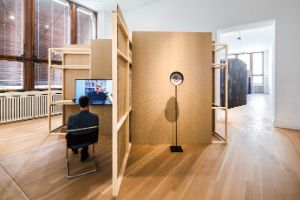
YOYI! Care, Repair, Heal, Kader Attia: Untitled, Installation view, Gropius Bau (2022)
photo: Laura Fiorio
Yhonnie Scarce: Missile Park
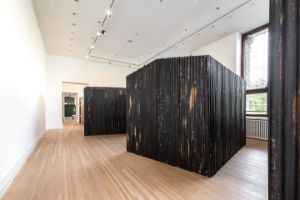
YOYI! Care, Repair, Heal, Yhonnie Scarce: Missile Park, Installation view, Gropius Bau (2022)
photo: Laura Fiorio
“The materials in Missile Park, corrugated zinc, bitumen paint and shellac reference the nuclear testing and the cover up of Aboriginal deaths.”
— Yhonnie Scarce
Missile Park (2021) takes its name from the tourist site in Woomera, southern Australia, which presents the history of nuclear rocket testing in the region. The installation encompasses three sheds that are scaled down replicas of the temporary housing built by the British military to support an extensive atomic programme in the 1950s and 1960s. The programme forced Yhonnie Scarce’s extended family, who are members of the Kokatha people, to leave their land. This displacement created not only immediate upheaval but also lasting trauma, as health issues due to radiation poisoning have been passed down through generations – the result of ongoing colonialisation and disregard for the people’s attachment to their ancestral homeland.
Inside the sheds, openings made by nails let light onto 20 spherical orbs with stem-like protrusions. These glass objects recall bush plums – a native food that grows on Kokatha land – but also bombs, dynamite or even human foetuses, referring to both the horror of nuclear testing and its lasting consequences.
Andrea Büttner: Grid | Untitled (Painted Ceiling) | Former plant beds from the plantation and “herb gardens,” used by the Nazis for biodynamic agricultural research, at the Dachau Concentration Camp | Karmel Dachau
Andrea Büttner looks at the notion of care in relation to environmentalism and organic lifestyles. The works on view address the legacy of National Socialist ideologies. Büttner draws attention to the ways ecological care has come at the price of brutality and human suffering, which healing from is impossible.
The three photographs depict overgrown plant beds and herb gardens set up by the Nazis at the Dachau concentration camp. They provided a setting for biodynamic agricultural research, where forced labour was used to tend the plantations and carry out experiments. The grid-like shape of the plant beds is echoed in Büttner’s wall painting as well as Untitled (Painted Ceiling) (2020). Büttner questions contemporary discourses – from art to gardening – which seem emancipatory but often aren’t. As part of her participation in the exhibition, she hosted a workshop titled Against Healing at the Gropius Bau in July 2022. She invited artists, scholars and curators to discuss the connections between right-wing movements and environmentalism, including research from the Nazi era – what has been termed the “brown [i.e. fascist] roots of the green movement”.
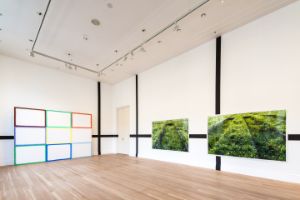
YOYI! Care, Repair, Heal, Andrea Büttner: Grid | Untitled (Painted Ceiling) | Former plant beds from the plantation and “herb gardens,” used by the Nazis for biodynamic agricultural research, at the Dachau Concentration Camp | Karmel Dachau, Installation view, Gropius Bau (2022)
photo: Laura Fiorio, © Andrea Büttner / VG Bild-Kunst, Bonn 2022
Pierre Adler: BordElle, André Eugene: Drums, Reginald Sénatus (Redji): Mur et Portes de Vertières
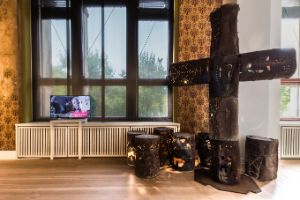
YOYI! Care, Repair, Heal, André Eugène: Kowona Kwonik | Drums, Installationsansicht, Gropius Bau (2022)
photo: Laura Fiorio
“What happens when the garbage of the post-colonial economy ends up on a creatively rich piece of land? A graveyard of barrels, car wrecks and electronic parts from which creators draw their materials, offering a post-apocalyptic vision of the world.”
— Giscard Bouchotte
Pierre Adler, André Eugene and Reginald Sénatus (Redji) are three individual artists living in a thriving community of makers in Port-au-Prince, Haiti. In 2000, André Eugene opened his studio as a Musee d’art (art museum) in the neighbourhood of Grand Rue, a disadvantaged area filled with street vendors and car repair shops. A group of former woodworkers, carvers and artists began a loose collaboration that led to the dynamic community Atis Rezistans (Resistance Artists).
The artists share a commitment to society and politics. They explore the legacy of the Haitian revolution, practices of voodoo and the Creole language. Originating in practices of recycling and repair, their works are marked by a fusion of material, style, beliefs as well as the use of humour. Some works repurpose and upcycle everyday materials – car and truck frames, metal scraps, nails, old shoes and even skulls. They draw from the industrial area of Grand Rue while experimenting with inventiveness and recombination. The works in this room enact makeshift techniques of assemblage that convey the energy of reinvention that drives their community.
Tabita Rezaire & Amakaba: Farmers’ Wisdom | Singing Bee Garden | Cacao d’Amazonie | Jardin Bois de Rose | Terre Rouge
“Let us feed the soil, so that our descendance can celebrate its fertility.” #SaveSoil
— Tabita Rezaire
How can we transfer art-generated knowledge to other fields of activity? In 2020, artist and spiritual seeker Tabita Rezaire became a farmer and started Amakaba – a centre for Amazonian wisdom in French Guiana.
Farmers’ Wisdom (2022) explores how land, societies and people can heal from the legacies of colonialism. The artist draws from Afrodiasporic and Indigenous systems of knowledge and practices of care, growth and transformation. Here, an adobe hut invites visitors to rest within the womb of the earth. The hut was built in collaboration with Natural Building Lab, part of Technische Universität Berlin’s Architecture Institute, and students of the university.
Inside, Rezaire interviews farmers in four videos, seeking their guidance as she starts her own journey in agriculture. Singing Bee Garden (2021) documents the relationship of mutual sustenance between beekeepers and their bees. Cacao d’Amazonie (2021) follows farmers’ mutual kinship with the forest, exploring how this translates in their labour. These videos inquire how local, scientific and spiritual knowledge is handed down through generations.
Tabita Rezaire, Farmers’ Wisdom, 2022. Installation view, YOYI! Care, Repair, Heal, 2022/23
© Gropius Bau, photo: Laura Fiorio
Brook Andrew: GABAN | Anatomy of a Body Record: Beyond Tasmania
YOYI! Care, Repair, Heal, Brook Andrew: GABAN | Anatomy of a Body Record: Beyond Tasmania, Installation view, Gropius Bau (2022)
photo: Laura Fiorio
“Creating GABAN in collaboration with Berlin-based creatives empowers a space that speaks back to the complex and traumatising museological ethnographic gaze. It is urgent that we activate radical self-love and control over how we reimagine powerful objects trapped within this system.”
— Brook Andrew
Brook Andrew is an Australian artist, curator and writer with matrilineal kinship from the Wiradjuri Indigenous nation. His practice aims to recentre Indigenous ways of being by imagining alternative futures. GABAN (2022) is a post-traumatic play set in an anthropological museum that summons a number of interlinked stories. Unfolding within Indigenous Australian understandings of time, the play – whose title means “strange” in Wiradjuri – aspires to create a space for murungidyal (healing) and a world beyond colonial trauma.
GABAN follows a number of powerful objects – based on cultural objects in museum collections – with both traumatic and empowering histories. For instance, the character MASSACRE is based on a letter written in 1854 by a white man, James Dixon, describing the slaughter of Aboriginal people in the Western District of Victoria. Shot in various institutions in Berlin and presented as a video installation – with live performances in September 2022 – GABAN aspires to reveal new pathways of intersecting histories to challenge prevailing narratives.
Paschal Daantos Berry: Dramaturg
Gary Stewart: Editor
Mouna Assali: Videographer
Brook Andrew: Videographer
Cammack Lindsey: Sound
Layana Flachs: Make-Up and Costume
Cherie Schweitzer: Production Manager
Magnus Elias Rosengarten: Stage Manager
Dr. Jessica Neath and Cheralyn Lim: Research (Brook Andrew Studio, Melbourne)
Cast
Aaron Reeder: MEMORY
Budi Miller: TREE
Dena Abay: EVIDENCE
Kameron Locke: PHOTO
Savanna Morgan: JUDGE
Joni Barnard: MASSACRE
Oumou Aidara: GUILT
Astan Meyer: GUIDE
Mohamed Boujarra: PUBLIC
Céline Rodrigues Monteiro: PUBLIC
Jota Ramos: PUBLIC
Black Pearl: PUBLIC
Marque-Lin: PUBLIC
Mmakgosi Kgabi: WITNESS
Kevin Bonono: MUSEUM
Johanna Hedva: The Clock Is Always Wrong
“But – care, repair and healing do not exist.”
— Johanna Hedva
What to do with the statement “time heals all wounds” when both time and healing do not exist? How does the body – of humans, animals, nonhumans, the earth and the supernatural – tell time?
The Clock Is Always Wrong (2022) communes with a selection of historical objects and manuscripts from the Wellcome Collection that connect to witchcraft, birth, sexuality, astrology and botany. Refusing the quantitative accumulation of capitalist time, Johanna Hedva’s works are staged as continuous with, and not separate from, the historical artefacts. All the objects in the room are kinds of clocks, keeping different scales of time – historical, cultural, personal, metaphysical. It is cyclical time, haunted, fated.
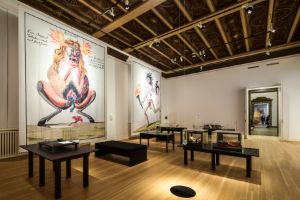
YOYI! Care, Repair, Heal, Johanna Hedva: The Clock Is Always Wrong, Installation view, Gropius Bau (2022)
photo: Laura Fiorio
Lygia Clark: Camisa de força (Straightjacket) | Rede de elásticos (Elastic Net) | Estruturação do Self (Structuring of the Self)
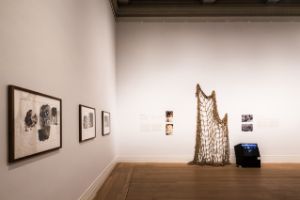
YOYI! Care, Repair, Heal, Paula Rego: Misericordia, Lygia Clark: Rede de elásticos (Elastic Net) | Estruturaçao do Self (Structuring of the Self), Installation view, Gropius Bau (2022) photo: Laura Fiorio
In the 1960s and 1970s, artist Lygia Clark took an interest in how art can be used as a form of healing and psychotherapy. With Relational Objects from the 1960s, she sought to treat participants, her “clients” as she called them, in individual therapeutic sessions. Clark used everyday objects such as plastic bags, seashells or stones in nets directly on client’s bodies. Her Camisa de forca (Straightjacket) (1969) is accompanied by a series of photographs depicting an activation of the work. The woman in the pictures tries to push along either end of the jacket, which is weighed down by stones, as if she were trapped. For Rede de elasticos (Elastic Net) (1974), Clark turned to participatory group forms and invited participants to engage with structures made of elastic bands. Participants could physically connect and feel themselves as a single, collective body.
Paula Rego: Untitled 1–8, Abortion Series | Untitled 2000/2020, Abortion Series | Untitled 2000/2020, Abortion Series | Misericordia I (Pedro Galdos), Misericordia V, Misericordia IV
Between 1998 and 2000, painter Paula Rego made a series of paintings and etchings each depicting a woman before, during or after an abortion. The series was triggered by a referendum opposing a new law that would decriminalise abortion in Portugal. In response, Rego made these works out of a sense of outrage, because she knew that this political decision would especially affect the poorest strata of the Portuguese population.
Some of the pictures depict schoolgirls, some young women. They face the viewer and stare back, unflinching. The pictures are about the women, not the medical procedure: Rego did not want grotesque imagery to put people off confronting the truth. That is why she deliberately avoided blood or graphic content. Nevertheless, in their directness, the works depict female empowerment in light of still ongoing attacks on bodily autonomy and the politicisation thereof. In 2007, nine years after the works were made, abortion was legalised in Portugal. These works demonstrate how art can help to achieve a social and political end.
The series Misericordia (2001), which means “mercy” in Portuguese, is loosely based on the eponymous novel written in 1897 by Benito Pérez Galdós. It was created when Rego’s mother was in a nursing home. The artist depicts intergenerational acts of care, such as dressing and feeding, and everyday examples of suffering and kinship. The juxtaposition of several scenes in one picture seems to diffract the story lines, evoking cycles. The cared for becomes a caretaker, before being, again, in need of care.
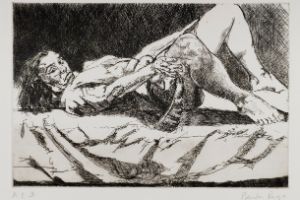
Paula Rego, Untitled 2, 1999. Etching, 19.6 x 29.7 cm, Paper: 38 x 48 cm
© Paula Rego, Courtesy: Paula Rego und Cristea Roberts Gallery, London
Outi Pieski: Rematriation of a Ládjogahpir – Return to Máttaráhkká
YOYI! Care, Repair, Heal, Outi Pieski: Rematriation of a Ládjogahpir – Return to Máttaráhkká, Installation view, Gropius Bau (2022)
photo: Laura Fiorio
“The Ládjogahpir today may be regarded as a symbol of a new decolonial feminism, forwarding amessage from our foremothers who live beside us. There is something utterly unique and powerful when Sámi women today wear this hat.”
— Outi Pieski and Eeva-Kristiina Nylander
Outi Pieski’s installation is part of the archival project The Ladjogahpir – The Foremothers Hat of Pride (2017–2021), which is conducted by the artist with the researcher Eeva-Kristiina Nylander. It is dedicated to a traditional Sámi women’s headpiece, the Ladjogahpir. Aiming to preserve and revive Sámi culture, the project focuses on the history of this hat, worn originally by Indigenous inhabitants of what is now northern Norway and Finland. Initially a fertility symbol, the wearing of Ladjogahpir was banned by 19th-century Laestadian priests, who interpreted the headwear’s protrusions and ritual functions as demonic. A large number of hats were subsequently destroyed. As a result of this colonial erasure, very few traditional Ladjogahpirs now remain in Sámi lands. Pieski and Nylander began inviting Sámi women to re-create these hats in workshops. In doing so, they work to repair and revive this important element of the Sámi culture. Bridging handicraft, archaeological research and social activism, their project also forms an inventory of the Ladjogahpirs as they exist in collections and archives. The rare artefacts on display here are on loan from the Museum of European Cultures in Berlin.
Lavkant Chaudhary: Maasinya Dastoor Series III
“How have we retaliated against injustice? How do we continue our claims on our traditional lands and territories, stolen from us in the name of development, in the name of nature conservation? What position will Tharu Indigeneity hold in an ever-changing world?”
— Lavkant Chaudhary
Lavkant Chaudhary is an artist of the Tharu community, a group native to the Terai, an ancient settlement in southern Nepal bordering northern India. His work examines links between historical oppression, the destruction of Indigenous livelihoods and ecological fragility.
Drawn with ink and pen on Lokta paper – a durable, handmade artisan paper – the scrolls of Maasinya Dastoor (2015–ongoing) form an archive telling the unofficial story of his community. The word maasinya means “enslavable” and recalls an 1854 decree (dastoor) that referred pejoratively to Indigenous people as an “enslavable alcohol drinking group”. Chaudhary superimposes imagery of Tharu activities over prints of colonial decrees from Nepali history. This shows how his people were oppressed by rulers who killed the sacred animals they worshipped – symbolised by the sculptures. These decrees were issued to exert control over Indigenous peoples. Examples include excessive taxation, establishing national parks on Tharu lands and forcing Tharu people to hunt and tame elephants.
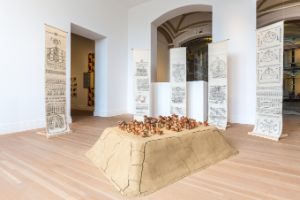
YOYI! Care, Repair, Heal, Lavkant Chaudhary: Maasinya Dastoor Series III, Installation view, Gropius Bau (2022). Commissioned by Colomboscope, Experimenter and Artree Nepal
photo: Laura Fiorio
Betty Muffler & Maringka Burton: Ngangkari Ngura (Healing Country)
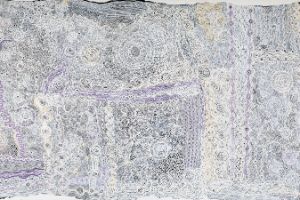
Betty Muffler und Maringka Burton, Ngangkari Ngura - Healing Country, 2022
© The artists, Courtesy of the artists and Iwantja Arts, photo: Andrew Curtis
“Uwa ngangkari kutjara ngali tjunguringkula palyanu. Wangka! ‘Pula ngangkari kutjarangku palyanu!’ Ngalimpa waakanguru-li ngali tjunguringkula palyanu ngalimpa walka.”
“Yes, we two ngangkari painted these together. Say ‘those two ngangkari have done these!’ Our paintings were done from our shared experience of working together as ngangkari.”
— Maringka Burton
Ngangkari Ngura (Healing Country) (2021) is a collaborative painting by two respected Pitjantjatjara artists. Working at Iwantja Arts in the small Anangu community of Indulkana, Anangu Pitjantjatjara Yankunytjatjara (APY Lands), South Australia, Betty Muffler and Maringka Burton are ngangkari, traditional healers. Ngangkari are highly regarded and have looked after people’s physical and emotional health for thousands of years.
Ngangkari Ngura (Healing Country) shows the landscape and waterways of Country as a site of healing. Country is a term that not only refers to a specific place but encompasses ideas of ancestral homeland, spirituality, language, identity and kinship. Colonialism, including the history of British nuclear testing, has damaged these lands. Muffler and Burton paint Tjukurpa – the creation stories and ceremonial designs to repair Country. Muffler paints the Emu Tjukurpa, a bird, and the movement of water. She also depicts the eagle spirit which belongs to her father. Like water, the eagle assists in bringing the spirits back to good health. Burton paints Anamara Piti, the creation story from her birthplace, about the caterpillar bringing life to the land and its people.
Grace Ndiritu: The Twin Tapestries: Repair (1915) & Restitution (1973)
“Museums are dying. My project Healing The Museum is an attempt to understand each other again by making the world a safer and more generous place.”
— Grace Ndiritu
Grace Ndiritu’s new commission focuses on restitution and repair as a way of investigating hidden Western museum practices in the 20th century and their legacy today.
The tapestries are based on two photographs, one taken in 1915 at the Wellcome Collection in London and the other in 1973 at the Ethnological Museum in Berlin. Both images depict museum workers posing with objects in a triumphant way. The images are imbued with a violent past that many collections are built on. Those depicted in 1915 are deceased and the image is in the public domain. The individuals photographed in 1973 have been digitally altered to consciously shift the discourse away from those still living. Instead, Ndiritu emphasises a wider debate around the history of European exhibition making and the type of institutions artists and curators today are asked to engage with.
The technique of tapestry consists of threads woven together, typically to form a pattern or motif. Ndiritu literally entwines past concepts and present concerns, laying the groundwork for the next generation of institutions. In doing so, she questions the accessibility of archives, ethics of representation and whether collections that are inherently colonial can ever be healed.
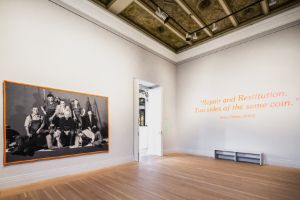
YOYI! Care, Repair, Heal, Grace Ndiritu: The Twin Tapestries: Repair (1915) & Restitution (1973), Installation view, Gropius Bau (2022)
photo: Laura Fiorio
Anne Duk Hee Jordan: Worlds Away | Clam Extravaganza
YOYI! Care, Repair, Heal, Anne Duk Hee Jordan: Worlds Away, Clam Extravaganza, Installation view, Gropius Bau (2022)
photo: Laura Fiorio
“Under water the world and perception is different, we feel pressure on the organs while being weightless at the same time – it is as if we perceive multidimensionally for the very first time.”
— Anne Duk Hee Jordan
Anne Duk Hee Jordan’s work explores post-human perspectives on ecology, technology and interspecies relations. Most recently, Jordan has been investigating the deep sea as a site beyond human imagination. Although inextricable from human activity through chemical spills, plastic waste and material transfer, it persists as a site that humans cannot fully see or conceptualise.
Worlds Away (2022) simulates a deep-sea environment, wherein otherworldly creatures glow with photoluminescence. Inspired by phytoplankton – self-feeding microscopic marine algae that dwells in ocean and freshwater ecosystems – the roomfilling installation is an immersive environment suggestive of the vertigo of floating in water. Jordan investigates how new forms of interspecies kinship can occur well beyond the reach of the destructive aspects of human activity.
Kader Attia: On Silence
“The use of silence produces absence. It is the most important strategy of all forms of domination that have been used from one people to another since the advent of modern reason. Because the absence of an account of the crime means that it did not take place.”
— Kader Attia
Kader Attia’s On Silence (2021) addresses the reticence and repression that envelop political violence by making visible that which is often passed over unsaid. These prosthetic limbs show their individual scars, stitching and seams. Detached from the bodies they were supporting, the prostheses echo the memory of the people they were a part of. They have become symbolic, nonorganic remains. They remind one of the wounds they once made up for and the pain they eased. The installation embodies physical and psychological traumas in an understanding of repair as a process of remembering rather than erasing.
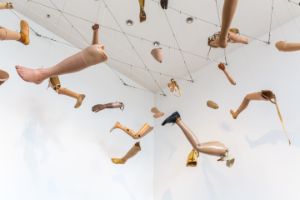
YOYI! Care, Repair, Heal, Kader Attia: On Silence, Installation view, Gropius Bau (2022)
photo: Laura Fiorio
Mohamed Bourouissa: Oiseaux du Paradis
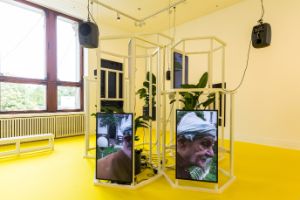
YOYI! Care, Repair, Heal, Mohamed Bourouissa: Oiseaux du Paradis, Installationsansicht, Gropius Bau (2022)
photo: Laura Fiorio, Courtesy: kamel mannour, Blum & Poe
“Upon entering the old hospital building, you get the feeling of segregation from the colonial era that transpires through the architecture itself.”
— Mohamed Bourouissa
In this video installation Mohamed Bourouissa investigates the garden of a mental hospital in Blida, Algeria. Tended to by patients, it is a site of collaboration and community where traumas are dispersed, germinated and healed. Psychiatrist and writer Frantz Fanon worked in this hospital from 1953 to 1956, where he witnessed the inherent structural issues at play. He did not believe in treating patients suffering from colonial alienation with methods imported by the same colonialists.
In conversations with Bourouissa, Bourlem Mohamed, a patient, describes his traumas: how French officers tortured him and the whispering of the ghosts. Admitted to the hospital in the 1960s, he benefited from Fanon’s reforms and took to gardening as a form of occupational therapy, linking botany, resilience and healing. In this installation, Bourouissa makes precise visual references that echo the video. The yellow carpet represents the blooming of acacias in the Algerian winter, following their migration from Australia through colonial-era expeditions. The strelitzia – also known as bird of paradise flower – originated in South Africa and embodies another pattern of displacement and resilience.
Artemisia Gentileschi: Susanna and the Elders
The baroque painter Artemisia Gentileschi’s Susanna and the Elders (circa 1610) depicts a biblical story from the Book of Daniel. Susanna was a married woman who was attacked by two older men while bathing in her garden. The men attempted to coerce her sexually by threatening to slander her if she didn’t comply. After refusing, she was disgraced, forced to go to court and was condemned to death. Finally, the prophet Daniel bid the court to reconsider, the men were later found guilty and executed.
The theme resonates with the artist’s own experience. A family friend who gave her art lessons raped her when she was 17. Her father insisted on reporting the assault to restore the family reputation. Gentileschi was tortured during the trial, adding to her trauma. Her life and work reveal transgressions of care, both from individuals and institutions. It is a historical milestone for a woman to depict the conditions of her complex experience and body from her own perspective.
Georgia Sagri: Inhale and Exhale with the mouth turned arms, Treatment 28 September, 2020 | Breathing (7_1_7) | Treatment, May 18th, 2020 Συνεδρία | Windface
“Pain must be acknowledged to be followed: not as a neglected code, that for centuries has been demonised, but as a bell and a compass of the unique conditions of our actual internal states, behaviours and affairs. When we listen through pain, there is the promise of change.”
— Georgia Sagri
The exploration of performance lies at the centre of Georgia Sagri’s work. The artist has developed a practice of care she terms IASI, in reference to the Greek word ίαση for recovery. This was born out of her need to prepare and recuperate from demanding performance pieces. IASI has since shifted into ongoing research on conditions like insomnia or fatigue, which Sagri calls “performance pathologies”. With IASI, the artist invites participants onto her Stage of Recovery, a bed-like frame upholstered with soft cushions, for individual sessions. On this stage, she guides participants through time-pacing, breathing, voice tuning and self-developed motion techniques in which air is the main element. Sagri methodically records these sessions as charcoal and coloured chalk drawings on paper, which she describes as “affective anatomies”. Dots, shapes and converging lines indicate zones of tension, release and the general feeling of a session towards recovery.
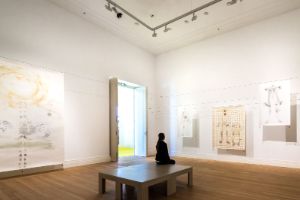
YOYI, Care, Repair, Heal, Inhale and Exhale with the mouth turned arms, Treatment 28 September, 2020, Breathing (7_1_7), Treatment, May 18th, 2020 Συνεδρία, Windface, installation view, Gropius Bau, 2022
photo: Laura Fiorio
SERAFINE1369: Venus is strong in the sky and I have no time for lack of heart nor lack of conviction
Can dance align our physical and spiritual bodies to reach a deeper awareness? This room-encompassing installation is continuing from SERAFINE1369’s live work When we speak I feel myself, Opening (2022). Performed in duet with Fernanda Muñoz-Newsome, the choreography consists of improvisational movements that emerge spontaneously from their bodies, alternating waves of stillness and motion. SERAFINE1369 infuses the installation with a sense of liveness through light, scale and props as well as both live and recorded sound, creating an immersive experience.
During performances, the artist draws on experiential research into craniosacral therapy and other somatic bodywork techniques which maintain the idea that bodies have the capacity to heal themselves. SERAFINE1369 explores the space of listening between sound and silence, doing and notdoing and imagination. This physical work or attention expands the present moment towards an altered state, where time is not linear and memories and visions rise to the surface.
Resonance Room
The ResonanceRoom shares local knowledge and experiences of mental health in Berlin. Since September 2021, a number of projects have developed that question the understanding of and approach to mental health in this city: How do individual health and society interact? How does history affect the present? What forms of care, solidarity and community are designed and practised in urban society? The resonance of different voices from the neighbourhood, academia and civic society can be experienced here. As a meeting place, the Resonance Room gathers these voices and engages them in dialogue.
The Resonance Room was developed by Margareta von Oswald, Mindscapes Curatorial Research Fellow and Diana Mammana, project lead of Neighbourhood Exchange at the Gropius Bau. Mindscapes is Wellcome’s international cultural programme about mental health. Other project partners are the Berlin University Alliance, Cashmere Radio e.V., Yeşil Çember and the Zentral- und Landesbibliothek Berlin.
YOYI! Care, Repair, Heal, Resonance Room, installation view, Gropius Bau (2022)
Photo: Laura Fiorio